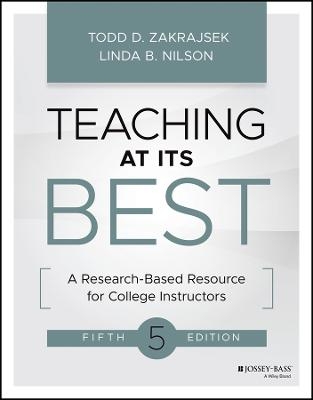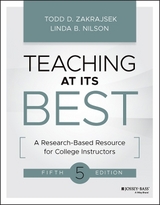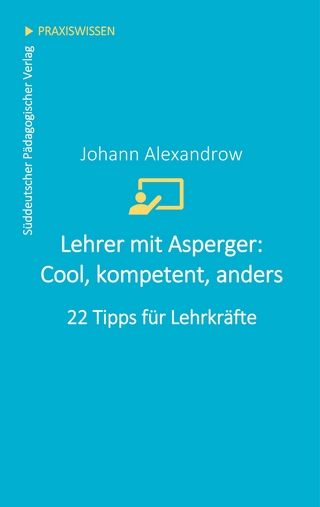
Teaching at Its Best 4e – A Research–Based Resource for College Instructors
John Wiley & Sons Inc (Verlag)
978-1-119-09632-0 (ISBN)
- Titel erscheint in neuer Auflage
- Artikel merken
The classic teaching toolbox, updated with new research and ideas Teaching at Its Best is the bestselling, research-based toolbox for college instructors at any level, in any higher education setting. Packed with practical guidance, proven techniques, and expert perspectives, this book helps instructors improve student learning both face-to-face and online. This new fourth edition features five new chapters on building critical thinking into course design, creating a welcoming classroom environment, helping students learn how to learn, giving and receiving feedback, and teaching in multiple modes, along with the latest research and new questions to facilitate faculty discussion. Topics include new coverage of the flipped classroom, cutting-edge technologies, self-regulated learning, the mental processes involved in learning and memory, and more, in the accessible format and easy-to-understand style that has made this book a much-valued resource among college faculty. Good instructors are always looking for ways to improve student learning.
With college classrooms becoming increasingly varied by age, ability, and experience, the need for fresh ideas and techniques has never been greater. This book provides a wealth of research-backed practices that apply across the board. * Teach students practical, real-world problem solving * Interpret student ratings accurately * Boost motivation and help students understand how they learn * Explore alternative techniques, formats, activities, and exercises Given the ever-growing body of research on student learning, faculty now have many more choices of effective teaching strategies than they used to have, along with many more ways to achieve excellence in the classroom. Teaching at Its Best is an invaluable toolbox for refreshing your approach, and providing the exceptional education your students deserve.
LINDA B. NILSON is the founding director of Clemson University's Office of Teaching Effectiveness and Innovation. Her career as a full-time faculty development director spans over 25 years. Along with four editions of Teaching at Its Best: A Research-Based Resource for College Instructors, she has authored three other books: The Graphic Syllabus and the Outcomes Map: Communicating Your Course (Jossey-Bass, 2007); Creating Self-Regulated Learners: Strategies to Strengthen Students' Self-Awareness and Learning Skills (Stylus, 2013); and Specifications Grading: Restoring Rigor, Motivating Students, and Saving Faculty Time (Stylus, 2015).
The Author Preface Part I: Preparation for Teaching 1 Understanding Students and How They Learn Your Undergraduate Student Body Profile How People Learn How Structure Increases Learning The Cognitive Development of Undergraduates Encouraging Cognitive Growth Teaching Today s Young Students The Challenge 2. Outcomes-Centered Course Design Why Outcomes-Centered Course Design? Writing Outcomes Types of Outcomes Types of Cognitive Outcomes Sequencing Outcomes into a Learning Process Helpful Frameworks for Designing a Course Showing Students Their Learning Process Outcomes-Centered Course Development The Big Picture 3. Building Critical Thinking into a Course Design The Many Faces of Critical Thinking Common Ground Critical Thinking Outcomes for Your Students Giving Students Practice in Critical Thinking The Goal: Critical Thinking in Everyday Life 4. Deciding What Technology to Use Choosing Technologies Intelligently How Faculty and Students View Technology Lecture-Related Software The Learning Management System The Flipped Classroom Social Media Mobile Learning in Class Laptops in Class Web Resources Miscellaneous Technologies The Future of Educational Technology 5. The Complete Syllabus How Long? How Extensive? The Case to Trim the Syllabus Essential Syllabus Items The Graphic Syllabus The Online Living Syllabus Getting Your Students to Read Your Syllabus Adding a Creative Element 6. Copyright Guidelines for Instructors Where Copyright Does and Does Not Apply Common Copyright Misconceptions Free Use: Fair Use, Facts, and Public Domain Printed Text Images In-Class Performances Recording Broadcast Programming Online/Electronic Materials and Distance Learning Obtaining Permission or a License How Copyright Violations Are Actually Handled For Further and Future Reference Part II: Human Factors 7. Creating a Welcoming Classroom Environment for All Your Students Planning a Welcoming Classroom A Welcoming First Day of Class Learning Students Names The Inclusive, Equitable Classroom Maintaining a Welcoming Environment 8. Enhancing Student Motivation Intrinsic and Extrinsic Motivation Students Perceptions of Motivators in Their Courses Students Values about College and Their Impact on Motivation Credible Theories of Motivation 55 Strategies for Motivating Students No Magic Bullets 9. Preventing and Responding to Classroom Incivility What Is Incivility? Why Do Students Behave This Way? Preventing Incivility: Your Classroom Persona Responding Wisely to Incivility Seeking Assistance 10. Preserving Academic Integrity How Prevalent Is Cheating? Who Cheats and Why? Detecting Cheating 42 Ways to Prevent Cheating Honor Codes Changing Student Values Part III: Tried-and-True Teaching Methods 11. Matching Teaching Methods with Learning Outcomes Types of Tools Has Our Knowledge Changed Our Teaching? A Tool for Organizing Your Course 12. Lecturing for Learning When and How Much to Lecture Preparing an Effective Lecture Delivering an Effective Lecture Incorporating Student-Active Breaks: The Interactive Lecture Inducing and Teaching Students to Take Good Notes Making the Lecture Effective 13. Leading Effective Discussions When to Choose Discussion Setting the Stage for Discussion at the Start of Your Course Policies to Encourage Participation Skillful Discussion Management Questioning Techniques Organizing Discussion Questions Turning the Tables 14. Coordinating Experiential Learning Student Presentation Formats Role Playing Simulations and Games Service-Learning and Civic Engagement: The Real Thing Maximizing the Value of Experiential Learning 15. Managing Productive Groups A Group by Any Other Name... The Case for Group Learning Cautions about Group Learning Managing and Troubleshooting In-Class Ad Hoc Groups Team-Based Learning Preparing Students for Life Part IV: Inquiry-Based Methods for Solving Real-World Problems 16. Inquiry-Guided Learning Definitions of Inquiry-Guided Learning The Effectiveness of Inquiry-Guided Learning The Need for Student Guidance Objects of Inquiry Modes of Inquiry Variations of Inquiry-Based Learning Upcoming Inquiry-Guided Methods 17. The Case Method The Effectiveness of the Case Method The Subject Matter and Websites for Cases What Makes a Good Case and How to Write Your Own Types of Cases Debriefing Cases A Postscript for Pioneers 18. Problem-Based Learning How PBL Works Good PBL Problems and Where to Find Them What Students Think Creating Your Own PBL Problems 19. Problem-Solving in the STEM Fields Where STEM Education Falls Short Improving Student Learning in STEM Courses: General Advice Improving Student Learning in STEM Courses: Specific Strategies Getting Real in the Lab Online Resources for STEM Education Why STEM Education Is So Important Part V: Tools and Techniques to Facilitate Learning 20. Helping Students Learn How They Learn Learning As an Inside Job The Learner s Questions The Evidence for Self-Regulated Learning Activities and Assignments for Every Occasion Self-Regulated and Self-Directed Learning Sources for Teaching Your Students How to Learn 21. Ensuring Students Prepare for Class Why Students Don t Prepare How We Can Equip and Induce Students to Come Prepared Specific Tools for Holding Students Accountable Managing Your Workload 22. Teaching in Multiple Modes Kolb s Learning Styles Model and Experiential Learning Theory (ELT) Felder and Silverman s Learning Styles Model Multimodal Learning Combining Modes 23. Making the Most of the Visual Mode How Visuals Enhance Learning Types of Visuals for Learning The Future of Visuals in Learning 24. Improving Student Performance with Feedback When Feedback Fails Student Peer Feedback Self-Assessment Student Portfolios Instructor Feedback: Helping Students Improve with It Classroom Assessment Techniques During-the-Term Student Feedback Part VI: Assessment and Grading 25. Preparing Students for Exams Test Preparation Measures Measures to Ensure Students Understand Our Language Anxiety-Reduction Measures What the Effort Is Worth The Power of Feedback 26. Constructing Student Assessments for Grading General Testing Guidelines Objective Test Items Constructed-Response Tests Items and Assignments Student Assessments as Teaching Assessments 27. Grading Student Assessments Grading Systems Grading Constructed Responses Grading Lab Reports How to Grade and Teach Mechanics at the Same Specifications ( Specs ) Grading Returning Students Work The Real Purpose of Grades 28. Assessing and Documenting Teaching Effectiveness What Is Teaching Effectiveness? What Student Ratings Do and Do Not Measure How to Improve Your Student Ratings Documenting Your Effectiveness A Comprehensive Approach to Faculty Evaluation Complex beyond Measure Appendix: Instructional Support and Resources at Your Institution For Faculty, Staff, and Students Just for Students References Index
| Erscheinungsdatum | 09.08.2016 |
|---|---|
| Verlagsort | New York |
| Sprache | englisch |
| Maße | 217 x 273 mm |
| Gewicht | 954 g |
| Themenwelt | Sozialwissenschaften ► Pädagogik ► Bildungstheorie |
| Sozialwissenschaften ► Pädagogik ► Erwachsenenbildung | |
| ISBN-10 | 1-119-09632-4 / 1119096324 |
| ISBN-13 | 978-1-119-09632-0 / 9781119096320 |
| Zustand | Neuware |
| Informationen gemäß Produktsicherheitsverordnung (GPSR) | |
| Haben Sie eine Frage zum Produkt? |
aus dem Bereich



